Underwater Adventures
The rainforests of the sea, coral reefs are vital for life on this planet and making them part of your next holiday could be the best way to ensure their protection, says Laura Gelder
Published January 2021
This is a feature from issue 3 of Charitable Traveller. Click to read more from this issue.
Living and breathing structures, coral reefs only cover a tiny section of the planet (0.1% of the ocean), but support a quarter of all marine species, making them one of the most valuable ecosystems. Reefs are vital habitats for thousands of species of fish, invertebrates, mammals and other organisms who depend upon them for food, shelter and protection as well as nursery and spawning grounds.
Without reefs, many marine animals wouldn’t be able to survive and our own survival would be threatened – the United Nations estimates that around one billion people globally depend on coral reefs for their food and livelihoods. In addition, coastal communities would be more at risk of damage during extreme weather events,
Since coral reefs are some of the most vibrant and visually stunning places on earth, it’s not surprising that an estimated one million new scuba divers are certified each year, with millions more opting to snorkel on holiday. Here are some ideas for a holiday under the sea…
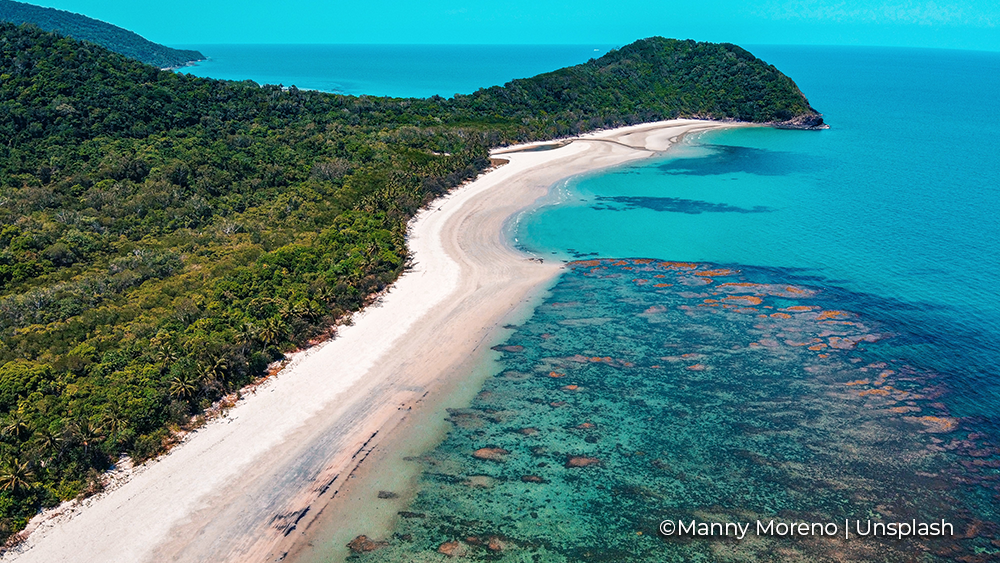
Australia
Stretching 1,400 miles from the south of Papua New Guinea almost to Brisbane, this is the world’s largest coral reef system, comprising 2,500 individual reefs and over 900 islands which can be seen from space. Here you can see 400 types of coral, 1,500 species of fish, and sought-after species like the dugong (sea cow) and green turtle.
Some of the stand-out spots include Agincourt Reef, where minke whales are often spotted between June and September; the Whitsunday islands, for their colourful shallow coral gardens and the chance to see the bump-headed Napoleon wrasse fish; and Heron Island which has a manta ray cleaning station, where the huge winged fish come to be nibbled clean by other fish.
Egypt
The warm waters of the Red Sea are packed with dives so colourful, it’s like being in the animated world of Finding Nemo.
Resorts like Sharm el Sheikh, Dahab and Hurghada have coral gardens just off their beaches for snorkellers, while further out lies buried treasure for divers.
The strong currents of the Straits of Tiran, the gap between the Sinai and Arabian peninsulas is home to four reefs and several shipwrecks and attracts stealthy hammerhead sharks. There’s also a vibrant forest of gorgonian fans, a delicate branching coral shaped like a fan.
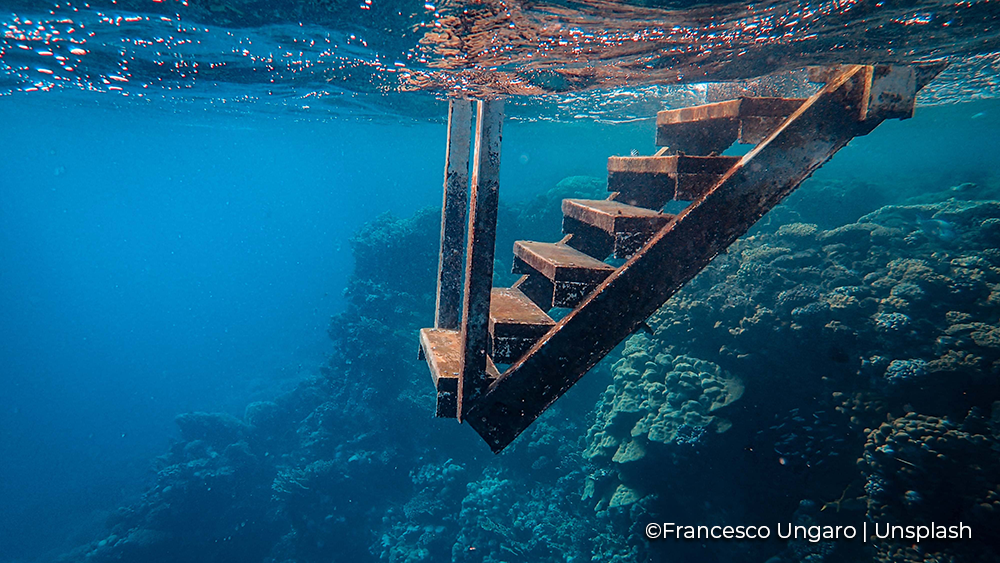

French Polynesia
This collection of five archipelagos covers an area of the Pacific the size of Europe and has an astounding choice of dive and snorkel sites. The abundance of lagoons makes ideal areas for novice divers and snorkellers who can drift gently over reefs and kaleidoscopic fish, while steep drop-offs and passes swept by strong currents provide thrilling challenges for advanced divers.
Tiputa Pass in Rangiora is a shark fanatic’s paradise where fast currents sweep divers along with hoards of grey reef sharks. Tuheiva Pass in Tikehau is home to schools of barracuda, tuna, manta rays, and sharks.
Galapagos
The incredible biodiversity of these Ecuadorian Pacific islands extends to beneath the waves too. Snorkellers have the opportunity to frolic with playful fur seals, green turtles are a frequent sight and harmless blacktip reef sharks tour the shallow coastal waters. Tagus Cove on Isabela Island offers the chance to spot rare sea horses, marine iguanas (pictured), penguins and flightless cormorants. Famous dive sites include Darwin’s aArch where mant rays, dolphins, eagle rays, and schools of sharks congregate, and Bartholomew Point where huge bait balls of fish sometimes attract penguins, sea lions, sharks, and rays.

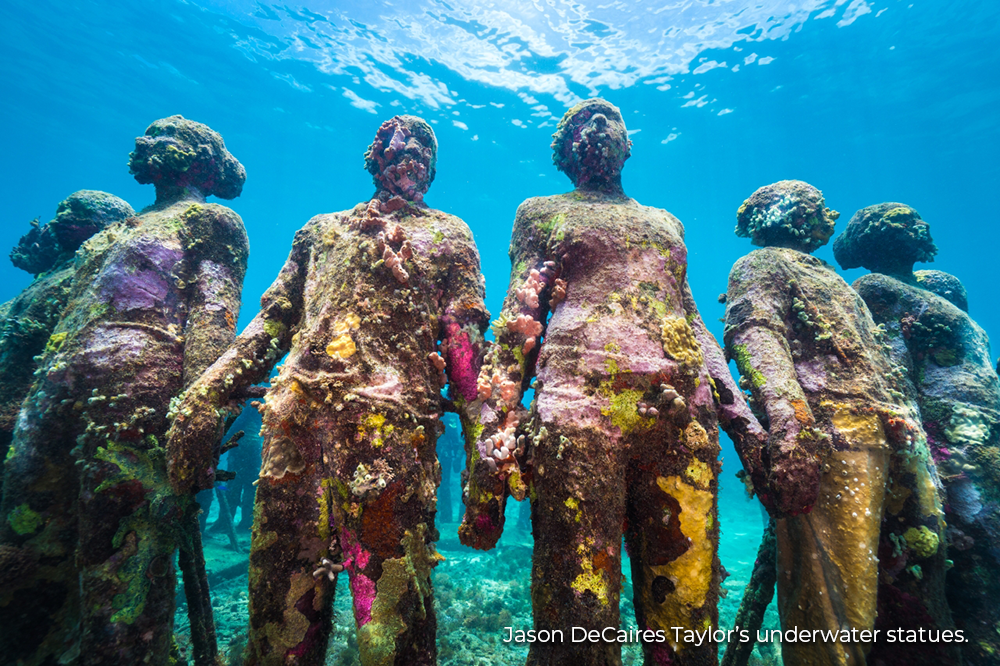
Grenada
This Caribean island’s most unique underwater attraction has to be the Molinere Underwater Sculpture Park. Create by famous sculptor Jason DeCaires Taylor, the signature piece is a life-size circle of ghostly looking children holding hands but others include a man on a bike, and a lone figure poised over a desk. The man-made figures have been subsumed by the sea and are covered in living coral.
The Island’s most famous dive is also an artificial reef – the MV Bianca C, a 600-foot former passenger liner, now how, to eels, sharks, and clouds of fish. Grenada is an important site for the endangered leatherback turtle and visitors can helps efforts by taking a tour with the St. Patrick’s Environmental and Community Tourism Organisation
Indonesia
The coral triangle is an area of exceptionally rich marine life and Indonesia runs along most of its base. Sulawesi Island has more varieties of coral than anywhere in the world and in the north its dramatic volcanic sub-aqua landscape is home to dugongs, or sea cows. Komodo Island, famous for its dragons on land, is a great place to spot the bizarre sunfish which looks like a full moon.
The Raja Ampat archipelago off West Papua is a dreamy landscape of karst islands surrounded by emerald water where divers can swim with huge pools of fish and see everything from pygmy seahorses to the bizarre Papua walking shark which walks across reefs and wiggles across tidepools.
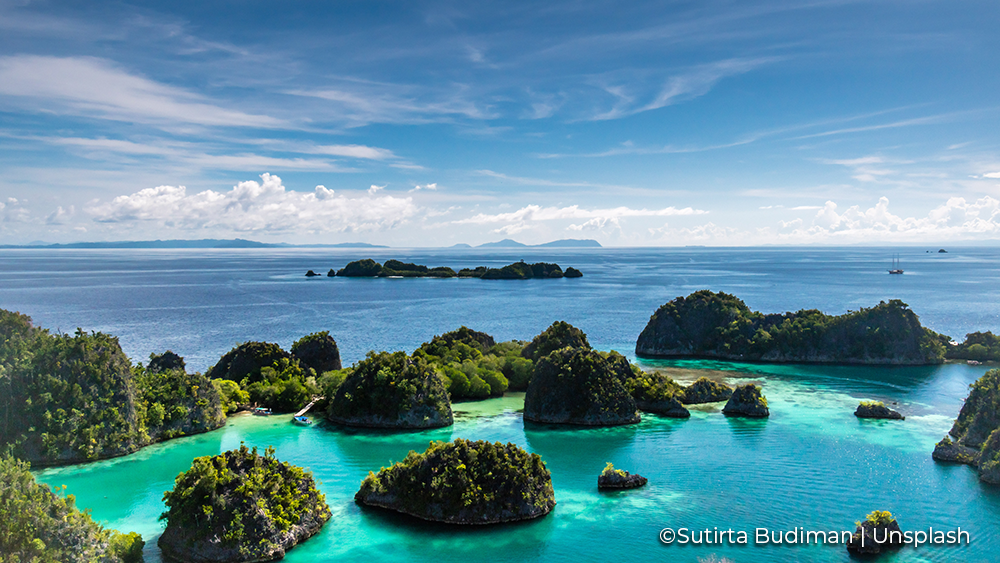
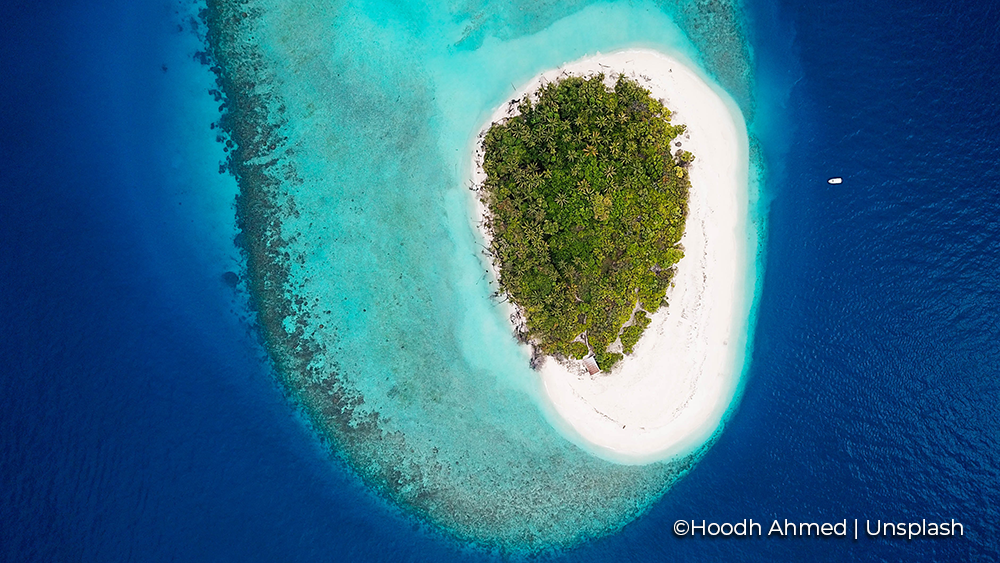
The Maldives
Some of the most nutrient-rich waters on the planet swirl around the dreamy atolls of the Maldives and their luxurious over-water villas. Deep channels cut between the atolls and are teeming with plankton, attracting larger species like sharks and manta rays, and offering exciting and challenging dives. Inside the atolls, reefs, sandbars, islands, and lagoons are colourful nurseries for smaller fish. Ari Atoll is the most renowned for diving and one the best places on earth to see whale sharks, the world’s largest fish at up to 18 metres long. December to April is the driest time and when seas are calm visibility on the eastern sides of the atolls is best. However, the best time to see manta rays is from August to November.
Malta
Malta and its sister islands of Gozo and Comino are renowned for their clear seas and craggy coast full of caves and underwater archways where lobsters, crabs, and eels lurk.
Reefs and wrecks – including a sunken British World War Two aircraft – are packed with colourful fish and finger sponges.
The Blue Hole is a famous dive on Gozo, a large limestone sinkhole about ten by five meters and fringed by rock like a natural swimming pool. Divers sink down past walls of vibrant coral tubeworms, sponges, and other marine life and pop through a rock window into the open sea.
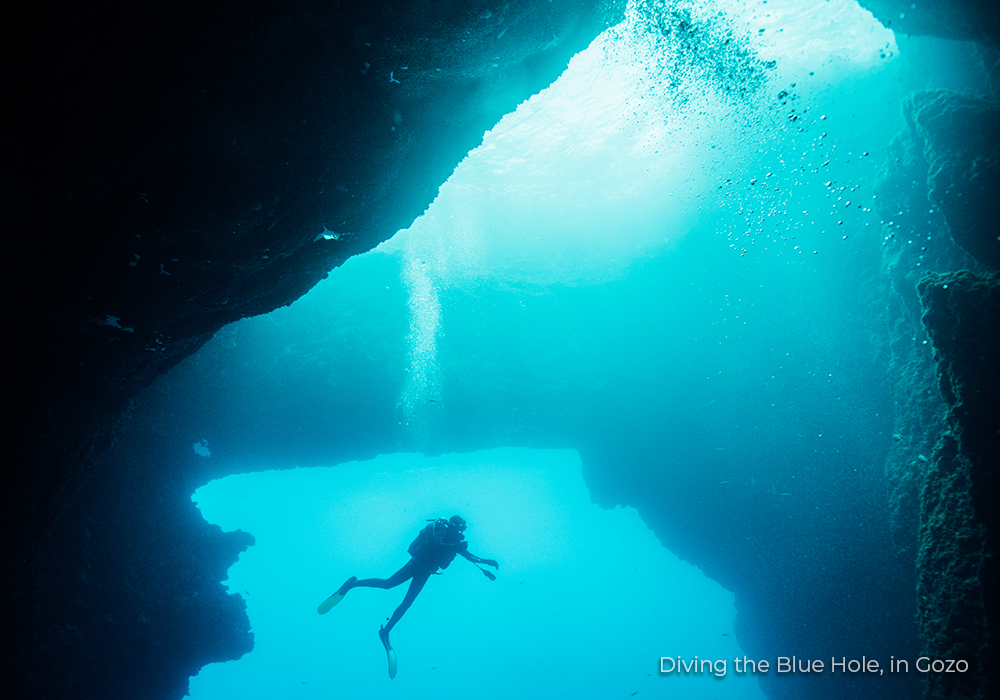

Malaysia
The islands off the east coast of Malaysia have lots of enchanting snorkelling spots. The Perhentian Islands are blessed with beautiful beaches and the chance to spot sea turtles and sharks, while Pulau Redang and six other islands form the Pulau Redang Marine Park and a protected area of coral reefs plus a shipwreck swarming with fish.
Further east, off the wildlife paradise of Borneo Sipadan Island is built on a volcanic seamount and famous diver Jacques Cousteau called it an ‘untouched piece of art’.
Awe-inspiring coral walls drop 600 metres and are smothered in hanging coral gardens. The area is famous for huge numbers of turtles, swirling masses of sharp-nosed barracuda, and schooling sharks as well as the chameleon-like flamboyant cuttlefish.
Philippines
The world’s second-largest archipelago – 7,000 islands no less – means a diverse and exciting marine environment. Hot spots include the wreck-dense Coron region and dramatic limestone cliffs of El Nido, both around the island of Palawan Island; Puerto Galera, which is a designated UNESCO Biosphere Reserve at the heart of the Coral Triangle region; and the Visayas which covers multiple islands including Apo Island off Negros, which is a marine sanctuary teaming with everything from schools of jack fish numbering 2,000 to tiny neon-coloured nudibranchs (a type of mollusc).
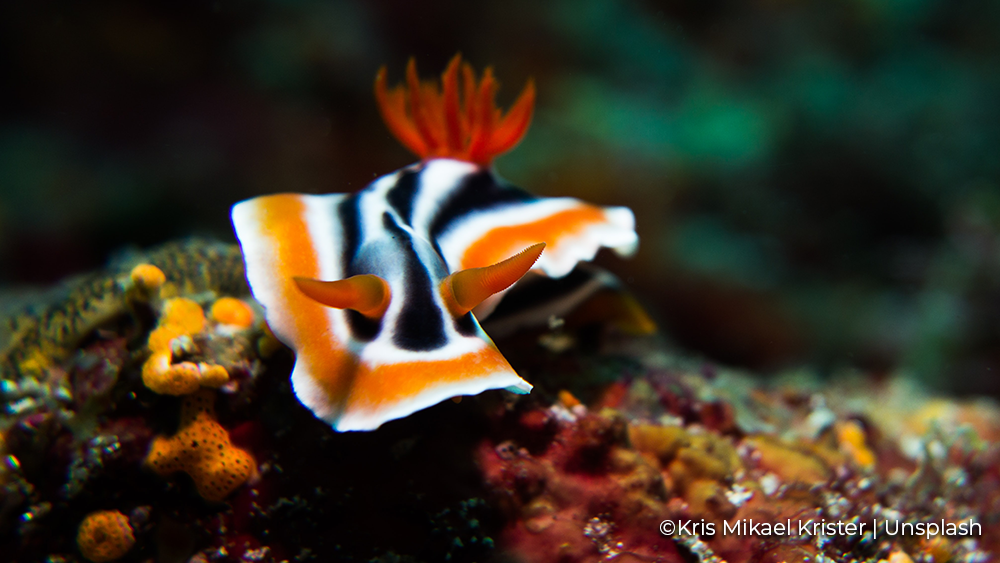

Thailand
Both coasts of Thailand have outstanding snorkelling and diving but the Andaman sea on the west is the best, especially from October to April. Off the Similan Islands’ white sand beaches are gin-clear water where snorkellers can fly over meadows of soft corals and sea fans with prolific fish.
Further north, the My Ko Surin National Park is home to Richelieu Rock, a huge pinnacle which just breaks the surface but sinks to 30 metres below, covered in pink and purple coral, and unusual small creatures like the ghost pipefish, which look like waving seaweed.
Coral guardians
The Reef-World Foundation says: “Take nothing but pictures, leave nothing but bubbles.” Follow their advice for seeing reefs responsibly:
Be careful
Don’t step on or touch coral, which can injure you and kill the reef; don’t touch or chase marine life – sharks, in particular, should be left alone as our presence can disrupt their natural behaviour and don’t stir the sandy bottom, it can damage and smother coral animals and spread disease on reefs.
Shop responsibly
Don’t buy souvenirs of shell, coral or other marine life, it encourages people to take them from the ocean, removing them from the ocean life cycle. And don’t take your own mementos from the beach – even dead ones as these break down and are recycled into the sea to give other animals nutrients.
Don't be rubbish
Throwing trash in the ocean kills marine life, poisons seafood and can cause injury. Minimise your use of single-use plastics and recycle or dispose of litter properly. You can also pick up any litter you see in the ocean or on the beach
Wear reef-safe sunscreen
Some chemical components in sunscreen – including Oxybenzone and Octinoxate – can have a negative impact on coral reefs.
Don't feed the fish
This can make them sick and some species, like sharks, aggressive, causing them to attack and injure humans. Fed fish are also more likely to leave their nests empty and vulnerable to predators
This is a feature from Issue 3 of Charitable Traveller. Click to read more from this issue.

















 by net effect
by net effect